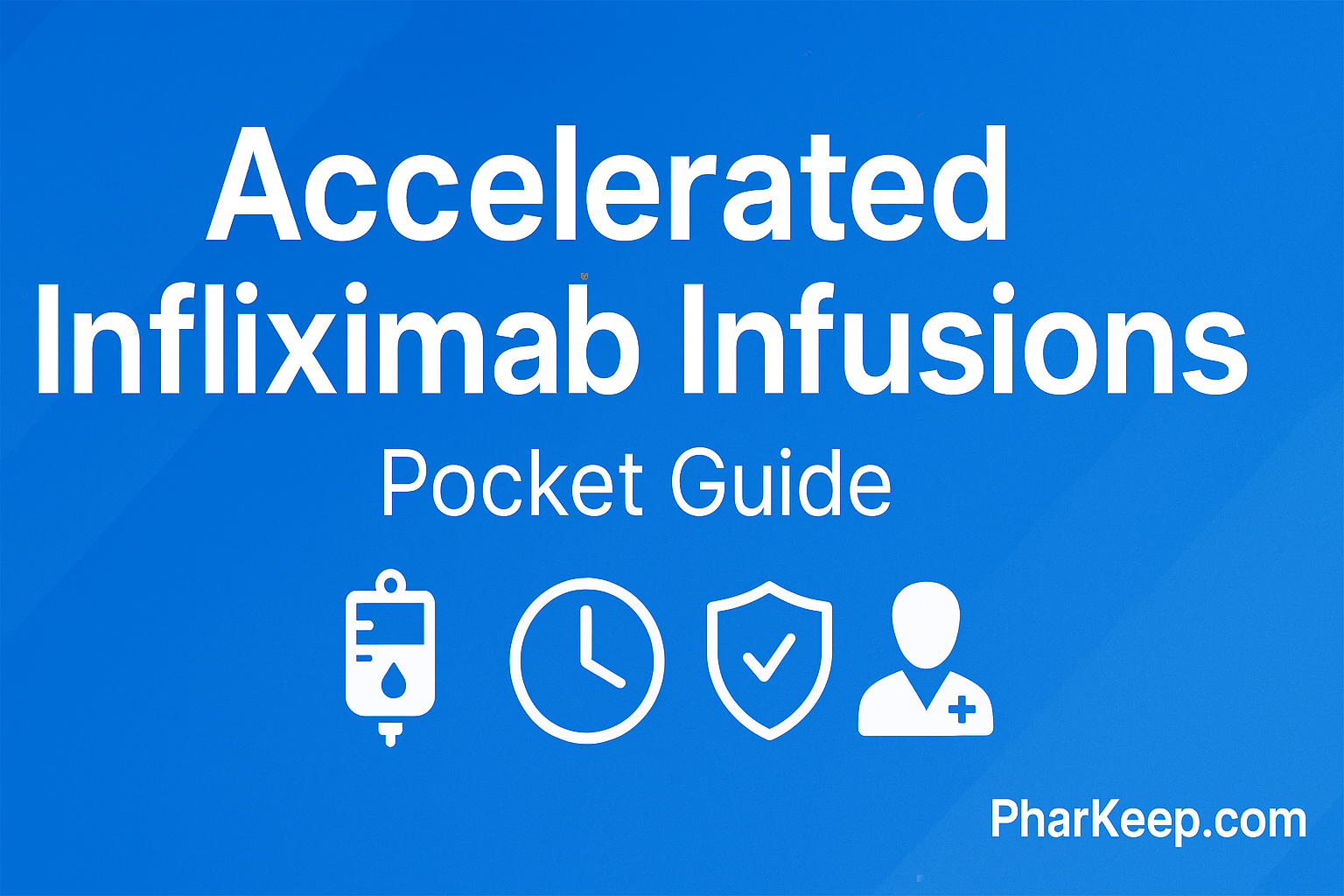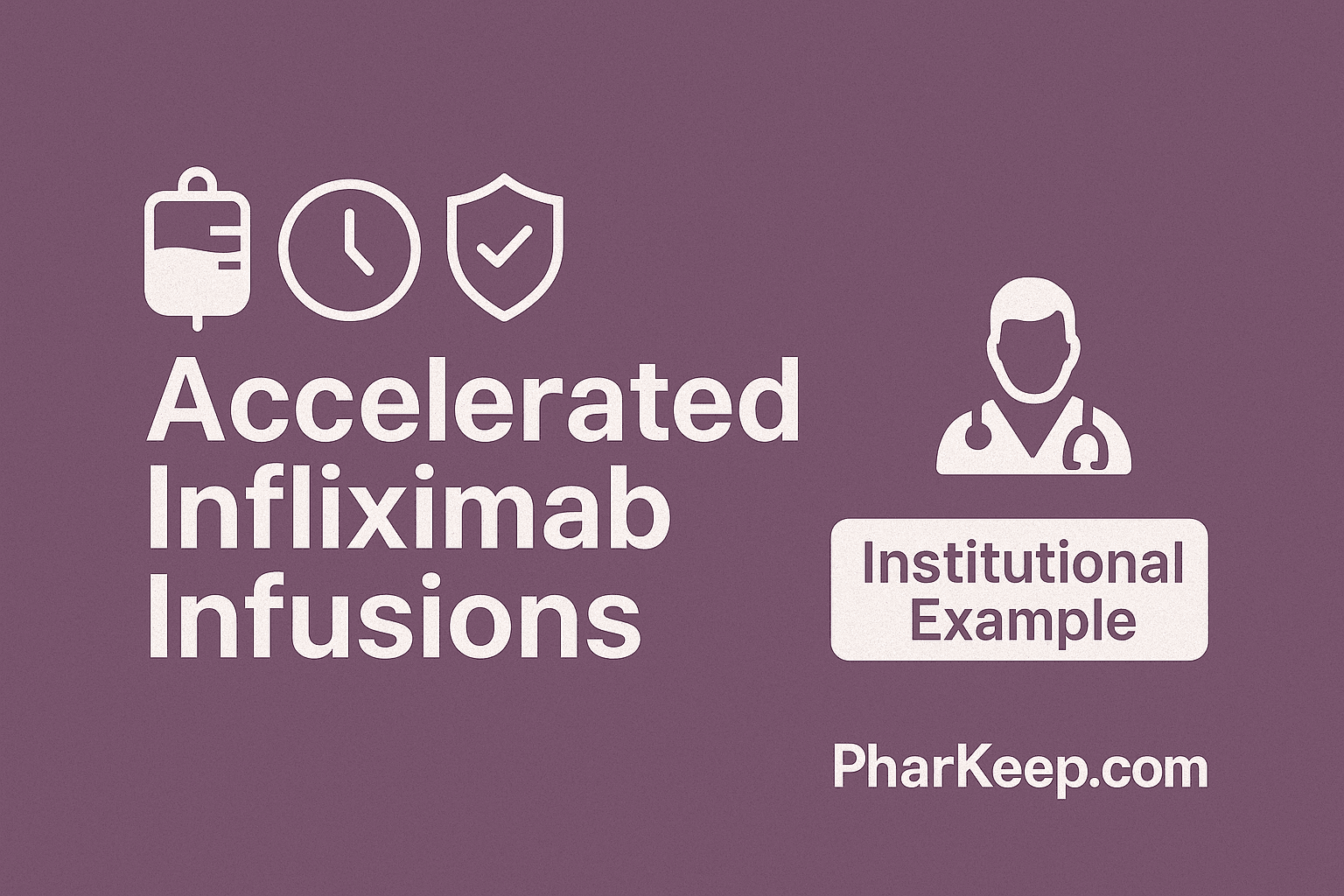Safe Transition to Accelerated Infliximab Infusions
Accelerated 60-min infliximab infusions are as safe as 2-hour infusions in maintenance patients who’ve tolerated prior doses. Most centers require ≥4 uneventful 2-h infusions, step down via 90 min, and revert to 2 h after any reaction or dose change.

Introduction
Infliximab and its biosimilars are widely used for conditions such as inflammatory bowel disease (IBD), rheumatoid arthritis, and psoriasis. Infusion pharmacists and nurses play a pivotal role in ensuring these infusions are delivered safely, particularly during the transition from standard 2-hour titrated infusions to accelerated 1-hour flat-rate infusions.
While infusion reactions are uncommon, they can be serious. Understanding the evidence behind accelerated infusions, proper patient selection, and standardized protocols allows infusion teams to improve patient convenience and infusion-center efficiency without compromising safety.
Why Infusion Duration Matters
Traditional protocols administer infliximab over 2–3 hours with titrated rates (slow start → gradual escalation).
Accelerated infusions (e.g., 60 minutes, often at flat-rate) can:
- Shorten chair time and improve infusion center throughput.
- Enhance patient experience and reduce time away from work or school.
- Reduce resource utilization (staffing, facility time).
Safety remains the primary concern, as infusion reactions—though rare—can occur at any stage. Most reactions happen during early induction doses; once a patient has tolerated several infusions, risk typically decreases.
Infusion Reaction Risk: Evidence Summary
Key points for infusion teams:
- The highest risk for infusion reactions occurs during first doses or after long drug-free intervals.
- Reactions are usually mild: flushing, pruritus, asymptomatic hypotension; severe reactions (e.g., bronchospasm, anaphylaxis) are rare.
- Concomitant immunomodulators (like azathioprine or methotrexate) may reduce reaction risk by lowering antibody formation.
- Premedication (acetaminophen, diphenhydramine, corticosteroids) is widely used, but evidence for prevention of mild reactions is inconsistent.
1-Hour vs 2-Hour Infusions: What the Data Show
Randomized trial (NCT05340764) in IBD maintenance therapy:
- Infusion reaction rate: 18% for 2-hour titrated infusions vs 12% for 1-hour flat-rate infusions.
- All reactions were mild, most often transient, asymptomatic hypotension.
- No severe reactions or infusion discontinuations were reported.
- The 1-hour arm was non-inferior in safety and reduced infusion-chair time.
Meta-analysis and large cohort data:
- Rapid or flat-rate infusions (≤1 h) do not increase reaction risk compared with 2-hour titrated infusions.
- Some pooled analyses show lower reaction rates with accelerated infusions (e.g., ~0.9% vs 2.2% per infusion).
- Pediatric studies likewise found low reaction rates (≈1.3% for 1-hour vs 2–3% for standard titrated infusions).
Clinical takeaway:
For patients who have tolerated several standard infusions, a 1-hour infusion is as safe as the 2-hour schedule and may slightly reduce reaction rates.
Transition Criteria: How Many Uneventful Infusions?
Most institutions require a minimum of 4 consecutive uneventful 2-hour infusions before moving to a 60-minute infusion.
Best-practice criteria before accelerating:
- No infusion reactions during at least 4 standard 2-hour infusions.
- No recent dose escalation or interval shortening.
- Stable vital signs and no pre-infusion concerns (e.g., fever, infection).
- Documented provider approval and patient consent.
⚠️ If a patient’s dose changes or any infusion reaction occurs, they should return to the standard 2-hour protocol before retrying accelerated infusions.
Stepwise Acceleration Protocol
| Phase | Minimum Tolerated Infusions | Infusion Duration | Notes for Staff |
|---|---|---|---|
| Induction | First 2–3 doses | 2 hours, titrated | Highest risk period; use standard premedication and close monitoring. |
| Maintenance (Step 1) | ≥ 4 uneventful 2-h infusions | Continue 2 h, consider flat-rate | Establish consistent tolerance. |
| Accelerated Phase 1 | ≥ 4 uneventful 2-h infusions | 90 minutes | Use if local protocol requires a transition step. |
| Accelerated Phase 2 | ≥ 1–2 tolerated 90-min infusions | 60 minutes (flat-rate) | Continue premedication if used; monitor vital signs at baseline, mid-infusion, and post-infusion. |
| Reversion Rule | Any reaction, dose change, or interval change | Return to 2-h titrated infusion | Document and reassess before future acceleration. |
Titrated vs Flat-Rate Infusions
- Titrated infusion: starts at a slower rate and ramps up every 15–30 minutes.
- Flat-rate infusion: runs at a consistent rate for the entire infusion time.
Evidence shows no increased reaction risk with flat-rate infusions in tolerant patients.
However, titration is still recommended for:
- Initial infusions, when the risk of reactions is highest.
- Patients with previous reactions or other risk factors.
Practical Monitoring for Infusion Teams
Before infusion:
- Review prior infusion records for reactions or dose/interval changes.
- Confirm eligibility for accelerated infusion.
- Check vitals and assess for any new symptoms or illness.
During infusion:
- Monitor vitals at baseline, mid-infusion, and end of infusion (more frequent if high risk).
- Watch for flushing, pruritus, dyspnea, hypotension, or chest tightness.
- Be prepared to pause or slow infusion at the first sign of a reaction.
After infusion:
- Observe patients for 30–60 minutes post-infusion, especially after their first accelerated dose.
- Document infusion details: rate, duration, vitals, premedications, and any adverse events.
Emergency readiness:
Epinephrine, corticosteroids, antihistamines, IV fluids, and oxygen should be immediately available.
All infusion staff should be trained in anaphylaxis management.

Tips for Pharmacists
- Verify that the patient has met the protocol criteria (≥ 4 uneventful 2-h infusions).
- Review recent labs (CBC, liver function) as appropriate per disease protocol.
- Check for changes in infliximab dosing or schedule that may require reverting to 2-h infusion.
- Counsel nursing staff and patients about potential signs of infusion reactions.
- Ensure standardized premedication orders and emergency medications are in place.
Tips for Nurses
- Double-check infusion order: duration, premedications, and special instructions.
- Use infusion pumps programmed for accurate rate control (especially for flat-rate infusions).
- Provide patient education about reporting early symptoms such as itchiness, chest tightness, or shortness of breath.
- Maintain calm communication with the patient to reduce anxiety during accelerated infusions.
Key Take-Home Points
- Safety first: Only accelerate infusions in patients who have demonstrated tolerance to several standard 2-hour infusions.
- Four uneventful 2-hour infusions is the common threshold before moving to 60 minutes.
- Stepwise approach: 2 h → (optional 90 min) → 60 min ensures safety and confidence.
- Flat-rate 1-hour infusions are as safe as titrated 2-hour infusions in tolerant patients.
- Pharmacists and nurses must remain vigilant in monitoring, documenting, and managing infusion reactions.
- If any reaction or dosing change occurs, revert to the longer protocol.
Conclusion
For infusion pharmacists and nurses, the evidence supports that accelerated infliximab infusions (60 minutes) are safe and efficient when applied to properly selected, previously tolerant patients. Adhering to a structured step-down protocol, maintaining robust monitoring practices, and ensuring readiness to manage reactions help maximize patient safety while improving clinic workflow.
References
- Abushamma S, et al. “Accelerated Infliximab Infusion Safety and Tolerability Is Non-inferior to Standard Infusion Protocol in IBD: A Randomized Controlled Study.” Crohn’s & Colitis 360 (2023). Trial reg. NCT05340764. PMC
- Mazzuoli S, et al. “Accelerated Infliximab Infusion: Safety, Factors Predicting Adverse Events, Patients’ Satisfaction and Cost Analysis.” PLOS ONE (2016). PLOS
- McConnell J, et al. “Accelerated infliximab infusions for IBD improve effectiveness.” World J Gastroenterol (2012). Protocol used 90- then 60-min after ≥4 prior infusions; no reactions reported. PMC
- Neef HC, et al. “Meta-analysis: rapid infliximab infusions are safe.” Aliment Pharmacol Ther (2013). RR not increased with ≤1-h infusions in previously tolerant patients. Deep Blue
- Rusch C, et al. “Rapid infusion of infliximab biosimilars and the incidence of infusion reactions.” J Clin Pharm Ther (2022). Rapid (≤60 min) infusions of biosimilars not associated with higher reaction rates. Wiley Online Library
- REMICADE (infliximab) US Prescribing Information (latest labeling). Confirms ≥2-h infusion in label and dose-intensification caveats. FDA Access Data
- Janssen MedicalConnect: “Shortened Infusion Duration of REMICADE.” Institutional rapid-infusion protocols (e.g., half-rate 15 min then full rate). J&J Medical Connect
- UK SmPC (product monograph): allows ≥1-h infusions in carefully selected adults after tolerating at least three initial 2-h infusions. static.janssen-emea.com
- Kaiser Permanente Washington Infusion Therapy Plan—Infliximab (REMICADE) Maintenance: requires ≥4 consecutive uneventful 2-h infusions before 60-min; documentation required; rules for reverting after reactions. Kaiser Permanente Washington
- Kaiser Permanente Washington Infusion Therapy Plan—Infliximab-dyyb (Inflectra) Induction + Maintenance (institutional protocol set). Kaiser Permanente Washington
- OHSU Knight Cancer Institute—Infliximab infusion order set (current institutional order template). OHSU
- Abushamma S, PubMed record (links trial reg. NCT05340764). PubMed
